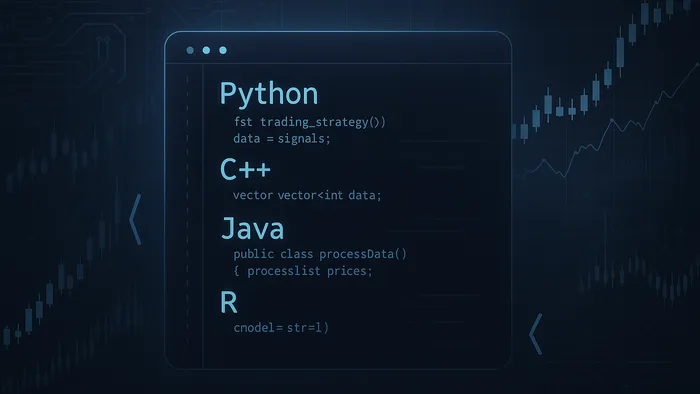Learn about the best programming languages for algorithmic trading, including Python, C++, Java, and R, and their unique advantages.
Algorithmic trading requires the right programming language to match your trading goals. Here's a quick guide to help you decide:
- Python: Perfect for beginners and strategy development. Offers powerful libraries for data analysis, machine learning, and backtesting.
- C++: Best for high-frequency trading (HFT) due to ultra-low latency and direct hardware access.
- Java: Ideal for large-scale, reliable systems with strong multi-threading and enterprise integration.
- R: Excellent for statistical analysis and market data visualization.
Quick Comparison
| Feature | Python | C++ | Java | R |
|---|---|---|---|---|
| Execution Speed | Moderate | Very Fast | Fast | Moderate |
| Learning Curve | Low | High | Medium | Medium |
| Best Use Case | Strategy development, backtesting | High-frequency trading | Large-scale systems | Statistical analysis |
| Market Adoption | Very High | High (HFT) | Medium | Medium |
Each language has its strengths. Python is great for prototyping, C++ for speed, Java for scalability, and R for advanced analytics. Choose based on your trading strategy and system needs.
When to Use C++ vs Python for High-Speed Automated Trading
1. Python for Trading
Python has become the go-to programming language for algorithmic trading, with more than half of developers using it for data analysis. Its combination of simplicity and functionality makes it appealing to both beginners and seasoned traders.
The language's clear and concise syntax allows traders to quickly develop and test strategies. Unlike Java's lengthy code or C++'s steep learning curve, Python lets users concentrate on crafting trading strategies instead of wrestling with syntax issues—a crucial benefit when swift market adjustments are needed.
| Feature | Advantage for Trading | Example Use Case |
|---|---|---|
| Data Analysis Tools | Easy market data processing | pandas for time-series analysis |
| Machine Learning Libraries | Detect patterns in data | scikit-learn for prediction models |
| Visualization Packages | Simplified trend analysis | matplotlib for technical charts |
| Testing Frameworks | Reliable strategy validation | VectorBT for backtesting |
Python's ecosystem includes powerful backtesting frameworks tailored to different trading styles. For instance, VectorBT is ideal for high-frequency strategies, while Backtesting.py offers a user-friendly approach for more traditional methods.
"Python is arguably the most appropriate programming language to research, backtest and implement backtesting strategies." – Martin Mayer-Krebs, Author
Key libraries in Python's ecosystem form the foundation of many trading systems:
- pandas: Handles time-series market data efficiently.
- NumPy: Performs complex mathematical computations.
- TA-Lib: Provides technical analysis indicators.
- scikit-learn: Integrates machine learning into trading models.
Modern trading platforms often support Python, enabling seamless integration from strategy design to execution. This allows traders to focus on refining their strategies rather than dealing with technical hurdles.
Next, we’ll dive into how C++ meets the demands of high-speed trading.
2. C++ in High-Speed Trading
C++ plays a crucial role in high-frequency trading (HFT) systems, where even a microsecond can mean the difference between profit and loss. By compiling directly to machine code, C++ eliminates interpretation delays, delivering the kind of execution speed needed to seize short-lived market opportunities. This makes it a go-to language for scenarios where raw performance takes precedence over ease of development.
| Feature | Advantage | Use Case |
|---|---|---|
| Direct Hardware Access | Ultra-low latency | Optimizing CPU interactions |
| Manual Memory Control | Fine-tuned performance | Custom memory management |
| Multithreading Support | Efficient parallel tasks | Executing multiple orders |
| Low-Level Operations | Maximum speed | Processing market data |
Specialized libraries further enhance its utility. Tools like Boost for advanced math, QuantLib for modeling financial instruments, and TA-Lib for technical analysis empower traders to squeeze every bit of performance out of their systems.
"C++ is undeniably a powerhouse in high-frequency trading. Its unparalleled performance, low-level programming capabilities, and robust support for concurrency make it an ideal choice for building trading systems that can keep pace with the demands of modern financial markets." – Digitalogy LLC
To make the most of C++ in HFT:
- Target performance-critical tasks: Use C++ for areas like order execution and processing market data, where speed is paramount.
- Optimize code structure: Techniques like loop unrolling, inline functions, and minimizing memory allocations can cut down latency.
- Test rigorously: Comprehensive unit and stress tests are essential to ensure stability, especially given the manual memory management required by C++.
Static typing in C++ also helps prevent costly numerical errors, making it an essential resource for firms aiming to achieve high transaction throughput and minimal latency. In an environment where every microsecond matters, C++ remains a key player.
Next, we’ll explore another language that offers a balance between speed and ease of use for trading applications.
3. Java Trading Applications
Java powers a staggering 85% of e-banking and trading operations. Its reliability and consistent performance make it a go-to choice for enterprise-level trading systems.
| Feature | Advantage | Use Case |
|---|---|---|
| Platform Independence | Works on any JVM-enabled system | Cross-platform trading systems |
| Multi-threading | Runs tasks in parallel | Deploying multiple strategies |
| Memory Management | Improves system stability | Ensures smooth trading workflows |
| JIT Compilation | Speeds up execution | Handles complex algorithms |
The Just-In-Time (JIT) compiler boosts Java's efficiency, especially for complex trading algorithms. While it may not match the raw speed of C++, Java's balance of performance and maintainability makes it a solid choice for scalable trading infrastructures.
Java also stands out in big data operations, thanks to tools like the Java Market Data Handler for CME MDP 3.0. These tools process market data updates in microseconds, making them indispensable for quick market analysis.
Some key strengths of Java in trading applications include:
- Concurrent Processing: Java's libraries handle multiple strategies at once, ensuring smooth operations.
- Enterprise Integration: Easily connects with trading platforms and enterprise systems.
- Risk Management: Features like strict type checking and exception handling minimize trading errors.
Java also excels in security. Frameworks like Spring Security provide strong authentication systems, which are critical for safeguarding sensitive trading operations.
"Technologies drive this market forward. Now, with the power of AI, you can offer personalized insights and automated trading options, making every decision feel like a well-informed partnership." – Nazar Kvartalnyi, Inoxoft's COO
Another major advantage? Java’s “write once, run anywhere” approach. This feature allows firms to deploy trading systems across various platforms without needing modifications. Combined with its efficient memory management, Java ensures reliability in high-stakes financial markets.
Next, let’s dive into how R provides advanced tools for market analysis.
4. R for Market Analysis
R stands out in statistical analysis, strategy creation, and backtesting—an essential advantage when algorithmic trading accounted for 60–73% of US trading volume by 2020.
| Package | Primary Function | Trading Application |
|---|---|---|
| quantmod | Financial Modeling | Historical data retrieval, market visualization |
| TTR | Technical Analysis | Moving averages, Bollinger Bands, MACD calculations |
| PerformanceAnalytics | Risk Analysis | Strategy evaluation and performance metrics |
R's built-in statistical tools make it a powerful choice for detailed market analysis. Its visualization capabilities, like those offered by ggplot2, allow for advanced trend displays, making it easier to develop trading strategies.
Here's an example: A moving average crossover strategy can use quantmod to gather historical data, TTR to apply technical indicators, and PerformanceAnalytics to assess performance metrics. For faster computations, R can work with C++ through the Rcpp package, blending R’s statistical strengths with C++’s speed.
R is particularly effective in time series analysis, risk evaluation, and strategy refinement. For traders focused on statistical arbitrage or quantitative strategies, R offers more robust tools for hypothesis testing and data manipulation than Python. Its vast package ecosystem supports everything from basic technical analysis to cutting-edge machine learning techniques, making it a standout choice in this comparison.
Language Comparison Guide
When it comes to algorithmic trading, understanding the strengths of different programming languages can help you choose the right fit for your needs. As of November 2022, Python leads the pack in popularity for trading applications, being searched 4.94 times more than Java and 55.56 times more than C++.
| Feature | Python | C++ | Java | R |
|---|---|---|---|---|
| Execution Speed | Moderate | Very Fast | Fast | Moderate |
| Learning Curve | Low | High | Medium | Medium |
| Memory Management | Automated | Manual | Automated | Automated |
| Trading Libraries | Extensive | Limited but efficient | Comprehensive | Statistics-focused |
| Best Use Case | Strategy development, backtesting | High-frequency trading | Large-scale systems | Statistical analysis |
| Market Adoption | Very High | High (HFT) | Medium | Medium |
Expert Opinions on Language Choices
Python stands out as the top choice for algorithmic trading. Martin Mayer-Krebs, an authority in the field, highlights its strengths:
"Python is the recommended programming language for algorithmic trading. It has the most mature ecosystem for quantitative analysis, ranging from data analysis libraries and backtesting frameworks to libraries that allow programmers to interface with stock brokers and cryptocurrency exchanges easily."
For high-frequency trading, C++ is the preferred option due to its unmatched speed. AlgoPro Academy explains:
"C++ is the go-to language for FX algorithmic trading strategies because of its speed, efficiency, strong typing, vast library of pre-built functions, object-oriented programming features, and a large community of developers and resources."
Key Performance Considerations
- Python: Great for rapid prototyping and strategy development but may fall short in ultra-low latency scenarios.
- C++: Delivers the low-latency performance needed for high-frequency trading but requires more development time.
- Java: Strikes a balance between performance, platform independence, and enterprise-level features.
- R: Ideal for statistical analysis but less suited for executing trades due to slower performance.
Each language has its own trade-offs. Python simplifies development and testing, while C++ offers the raw speed needed for execution systems. Java provides a middle ground, and R specializes in statistical tasks. The right choice depends on your specific trading goals and technical requirements.
Making Your Choice
Pick a programming language that aligns with your trading goals, experience level, and system requirements.
For Beginners
If you're just starting out, Python is a great choice. Its simple, readable syntax and vast ecosystem make it perfect for building your first trading algorithms. The ease of learning Python allows you to concentrate on crafting strategies rather than getting bogged down by technical programming details.
For Performance-Critical Systems
For high-frequency trading or situations where speed is absolutely critical, C++ is the go-to. Its ability to control memory at a low level helps reduce latency, making it ideal for systems where even microseconds matter.
Here's an example of how you can divide tasks based on language:
| Trading Component | Recommended Language | Reason |
|---|---|---|
| Strategy Development | Python | Quick prototyping and testing |
| Data Analysis | Python/R | Extensive statistical and data libraries |
| Core Execution Engine | C++ | Low latency and direct hardware access |
| Risk Management | Java | Reliable error handling and stability |
This setup often leads to a hybrid approach.
Hybrid Approach
Combining multiple languages allows you to take advantage of their individual strengths. Many teams use this strategy to balance quick development with high-performance execution.
Cost and Resource Considerations
Practical factors also play a role in your decision. Think about development time, your team's expertise, hardware capabilities, licensing costs, and ongoing maintenance. If microsecond-level speed isn't a priority, Python's faster development cycle might be more appealing than C++'s performance edge. The right language ultimately depends on your trading timeframe and the complexity of your strategies.








